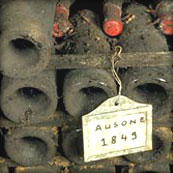![]() Winning claret
Winning claret
What's a claret? It's an old name, rather British, for a red Bordeaux blend. Today let's take a look at an American version - a.k.a. Meritage - that was the people's choice in a recent tasting here.
Hahn Estates 2006 Central Coast Meritage Red Table Wine won a consumer taste-off among six "claret" wines - three Merlot-dominant Right Bank Bordeaux and three California Bordeaux blends - ranging in price from $18 (for this one) to $30-plus.
Even as the lowest-price wine of the group, the Hahn won "easily," said John Johnson, proprietor of The Wine Rack on Louisville's historic Frankfort Avenue, a shop that wins my affection for a small but eclectic collection and, mainly, for Johnson'a excellent knowledge of wine and food. It also bears the distinct advantage of being the only wine shop in the world that I can walk to from my home in five minutes.
Before we head for the tasting report, let's take a moment to refresh our memory on two relevant wine terms:
Claret, as noted above, is an older term, originally British, for red wine, specifically Bordeaux. It likely stems from the French "Clairet" ("Cleh-RAY"), used in early times to distinguish the light, clear Bordeaux reds from their more dark and murky competition. Clairet has been resurrected in modern times, at least as a niche market, as a light, fruity and early-drinking Bordeaux available at modest prices. I haven't seen it outside France. But when you read or hear of "claret," you can assume that the topic is a Bordeaux-type red.
(This article was published in The 30 Second Wine Advisor on Monday, Oct. 20, 2008 and can be found at http://www.wineloverspage.com/wineadvisor2/tswa20081020.php.)
![]() How old can Beaujolais go? (30/09/2008)
How old can Beaujolais go? (30/09/2008)
Beaujolais is a benchmark case of a wine not meant for aging.
Indeed, the annually promoted Nouveau Beaujolais, which will hit the news as usual when it arrives in November, is one of the most short-lived wines on Earth: The old conventional wisdom was that you bought it in late November and drank it up before New Year's.
Modern times have improved that record a bit, but it's generally a good idea to drink Nouveau within a few months (if at all, he adds snidely), and regular Beaujolais and Beaujolais-Villages within a year or two after the vintage.
But as with every rule, you'll find an occasional standout exception. In the case of Beaujolais, the exception comes in the region's "Cru" wines, those made from the vineyards around 10 specific villages so highly regarded that their wines are labeled with the village names rather than the generic "Beaujolais." Here's your shopping list: Brouilly, Chénas, Chiroubles, Côte de Brouilly, Fleurie, Juliénas, Morgon, Moulin-a-Vent, Régnié and Saint-Amour.
Just like the Nouveau, generic Beaujolais and Beaujolais-Villages, the "Crus" are made 100 percent from the Gamay grape; and in their youth they do share the variety's fruity strawberry character. But - particularly from the best artisanal producers - they add intriguing complexity and subtle minerality that you won't find in the simpler wines;
Unlike the more basic Beaujolais, a well-made "Cru" can evolve and gain interest with a few years of careful cellaring. With good luck it will develop into something bearing at least a cousinly kinship to Burgundy's Pinot Noir. (And it should be noted that, in ancient times, Gamay was permitted in Burgundy; and Beaujolais is legally considered the southernmost part of the Burgundy region and may optinoally carry the English legend "Red Burgundy Wine" on the label.
The other day, looking over some dusty bottles in a corner of my modest collection, I discovered a "cellar orphan," a single bottle of "Cru" Beaujolais that I had received as a gift from a friend years ago and frankly forgotten was there. A Juliénas subtitled "Cuvée Prestige" from Michel Tête's Domaine du Clos du Fief, it bore the 1999 vintage on a neck label.
A nine-year-old Cru Beaujolais? Who knew? Could it be any good? A look at the cork was reassuring: Well over an inch long, it was the kind of substantial, relatively costly stopper that producers rarely use unless a wine is meant for the cellar. The cork came out solid, firm and clean, and while a lot of red-clay earthiness rose from the bottle, so did good, ripe Gamay strawberry aromas.
The wine was fine, and a later peek at the Website of the importer, New York City's Michel/Dressner, indicated that I shouldn't have expected any less. Tête's Cuvée Prestige "is aromatically backward in its youth, and its dense, velvety matter develops harmoniously with some bottle age," Dressner wrote. That sounds about right to me.
Unfortunately, you'll be hard-pressed to find 1999 Tête Juliénas on the open market. But Wine-Searcher.com shows more recent vintages back to 2004 selling in the U.S. in the $19 to $25 range, and that's a pretty comfortable niche for a cellar-worthy wine. (The 30 Second Wine Advisor)
...........................................................................資訊來源:騰訊論壇
[1] [2] [3 ] [4] [5 ] [6 ] [7 ] [8] [9] r[10] [11] [12]
 a
a